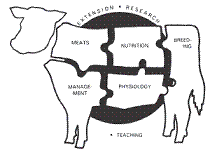Animal Science, Department of

Nebraska Beef Cattle Reports
Date of this Version
2022
Citation
2022 Nebraska Beef Cattle Report
UNL Beef, Institute of Agriculture and Natural Resources, University of Nebraska-Lincoln
Abstract
Production of cow-calf pairs and grow/finish performance of calves from a partially-confined, fall-calving, intensive cow-calf system were compared to a traditional, spring-calving, extensive cow-calf system. Body condition was lower at breeding and weaning for the fall-calving alternative system compared to the traditional, spring-calving system. Conception, calving, and weaning rates were not different among treatments. Weaning weights were lower for the fall-calving alternative system than traditional, spring-calving system. Following weaning, calves were grown for 117 d and then subsequently finished to the same target fatness for both systems. In the grower phase, gain was greater and feed conversion improved for the fall-calving alternative system. In the finishing phase, gain was lower for fall calving alternative system compared to traditional, spring-born calves. Intakes and carcass weight were not different among treatments during finishing, but calves from the fall-calving alternative system were fed 27 days more. The use of a fall-calving alternative cow-calf system had no impact on reproduction and weaning rates demonstrating potential value if pasture acres are limiting in areas with abundant crop acres, but calves will need to be grown longer to overcome lighter weaning weights.
Included in
Large or Food Animal and Equine Medicine Commons, Meat Science Commons, Veterinary Preventive Medicine, Epidemiology, and Public Health Commons

